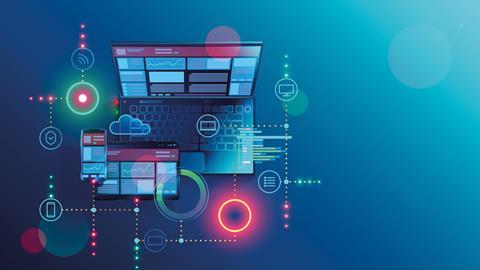Recent years have seen a massive infusion of tech talent and investment into the legal sector, and the pandemic has accelerated digitisation and innovation. The focus now needs to be on interoperability – creating dynamic connections between different legal processes and resources.

At a Thomson Reuters SYNERGY virtual event, legal technologist and futurist Joseph Raczynski presented a session on ‘legal platforms, APIs and the (r)evolution of whizzbang legaltech’. An API, or Application Programming Interface, is the software that enables applications to connect with each other and exchange information. As Raczynski observed, in the past five years there has been a tenfold increase in legal tech start-ups, most of which operate in the cloud and solve specific issues. But without common standards for the developers of these point solutions, interoperability between new and existing legal tech solutions is a big challenge.
Playgrounds for innovation
Interoperability underpins the growing phenomenon of curated legal tech platforms, which are basically app stores for legal tech products. Developers who want their app to be available on these platforms have to code to specific standards so that all apps on the platform are scalable and can work together, and with third-party applications such as Microsoft 365 and Google Workspace. Raczynski explained that a platform creates an environment for collaboration and innovation, by setting standards for governance, coding and security, and enabling interactions between the products on the platform. This creates a framework that subscribers and third parties can use to develop innovative new products.
Some connections are part of the supply chain, like the OIC portal, but others, like checking someone’s photo identity, are optional add-ons. It is important to choose what you’re going to be famous for when deciding whether to create your own tools and systems
Jon Grainger, Slater and Gordon
While the pioneer in the legal tech space is Reynen Court, which is supported by some of the world’s largest law firms, Thomson Reuters’ acquisition of HighQ enabled them to build their own plug and play platform. Other firms and vendors are following suit, building what Raczynski described as ‘a playground for innovation’.
Raczynski went on to describe how this approach helps lawyers collaborate, automate and manage their work: ‘You can pull in third-party applications as and when you need them, knowing they are all coded in the same language, to the same standards and everything works together.’
Legal tech investor Mike Suchsland, venture partner at Bridge Investments, whose portfolio includes successful legal tech scale-ups, explained how these developments are changing the competitive environment for legal tech vendors. They are also helping to level the playing field ‘between a provider who wants to put together an all-in-one solution that benefits from brand and channel scale advantages, versus the provider who develops a point solution, but then writes APIs to other point solutions for easy interoperability to compete with the scaled player. The legal arena is evolving toward the scaled solution, and we are seeing this in areas like eDiscovery, workflow management and contract management.’
On the right path?
A key challenge is that government legal services portals are generally designed around two pathways – the citizen journey and the lawyer journey. This is surprising given the government’s ongoing support for lawtech start-ups and innovation. Lawtech scale-up amicable, which is not a law firm but a divorce services company that works with separating couples without formally representing them, does not fall into either category, so is unable to access the government’s online divorce portal. Co-founder Kate Daly explains that amicable is currently working with the Ministry of Justice to address this. ‘We feel it is important that new models have the same access to [government] IT systems as traditional law firms and [should not be] at a disadvantage when they are offering consumer choice and access to justice.’ The company uses technology to expedite negotiations. ‘We are developing our services to blend technology and human support. Big data allows us to build algorithms to narrow negotiation ranges and predict settlement outcomes,’ she adds.
Self-service support
Closer to home, new self-service government portals are catalysts for legal tech innovation that is predicated on a combination of self-service, expert support and interoperability.
The MoJ Official Injury Claims (OIC) portal is designed to enable victims of road traffic accidents to make personal injury claims without using a lawyer. However, due to the nature of these claims most claimants do not represent themselves. The whiplash reforms, which came into force on 31 May (tinyurl.com/2ack3uhz) and affect both compensation and recoverable costs, are forcing firms that specialise in this type of work to look for technology solutions to help them support claimants who require advice and guidance.
NewLaw Solicitors, which specialises in handling personal injury claims for insurers, accident management companies and membership organisations, needed to redesign its operations so that it could recover compensation for customers and remain profitable under the new regime. It turned to an external developer to build a software solution to process claims differently.
The result is personal injury portal Pilot, which combines a semi-automated workflow with professional legal advice. ‘Our legal experts work alongside our customer-facing portal, which integrates with the OIC portal,’ explains managing director Tim Lock.
While Pilot allows customers to manage their own claims through the OIC portal, ‘they can still access legal expertise when they need it, but at a lower cost’. Although the firm was driven to innovate by external developments, Pilot has transformed the way it interacts with customers, who have 24/7 access to their cases, and has reduced the admin burden on claims-handlers, as it also interfaces with the firm’s case management system. Lock envisages applying a similar approach to other products.
The rationale for these self-service offerings is that while government portals are designed for consumers to handle legal processes without a lawyer, most users require some professional guidance. As Slater and Gordon CIO Jon Grainger observes, this is because most people only employ a lawyer (for anything) once every seven years, and therefore do not necessarily understand their legal rights and responsibilities.
Like NewLaw’s Pilot, Micase Road Traffic Accident (RTA) from Slater and Gordon is a self-service, end-to-end online tool that connects with the OIC portal and allows claimants to manage their own cases and contact a lawyer for guidance and advice when they need it. However, instead of charging a fee, it offers ‘no win, no fee’ legal representation. Micase RTA is available via Slater and Gordon’s website on any device.

Micase RTA, which also integrates with partners and insurers, is the first self-service tool to go live from a central digital legal platform, which reflects the firm’s ‘creative automation’ strategy or, as Grainger explains, deciding exactly where you need a human in the loop. This involves ‘using micro-AI to make small decisions, leaving the big decisions to our customers and fee-earners’, he says. ‘Miplatform is a collection of components that form a common purpose. We build all our APIs in miplatform, so that we can reuse them each time we create a new digital legal service, and all our products benefit from these connections.’
Both Lock and Grainger have had to work around issues with the OIC portal, including designing a system that interfaced with a portal that had not yet launched. ‘Developing Pilot at the same time the OIC portal was being built presented a number of challenges as the goalposts regularly moved throughout,’ says Lock. ‘We compared it to fitting out a house and leaving some cables dangling out of the ceiling in the hope that at some point we could fit a light to it. It’s fair to say there are a few metres of wasted cable!’
Grainger highlights considerations when building APIs that connect with external organisations. ‘We have built in contingencies so that we can handle OIC service interruptions that require us to queue without disrupting the flow of our business. Security is critical when connecting to any external system,’ he adds, explaining that miplatform includes integrations with identity-checking and compliance services.
Grainger recommends developing an API strategy. ‘Some connections are part of the supply chain, like the OIC portal, but others, like checking someone’s photo identity, are optional add-ons. It is important to choose what you’re going to be famous for when deciding whether to create your own tools and systems or link to external resources.’
In-app integration
Law tech start-up Legal Utopia connects individuals and small businesses with legal information and resources. Its self-help Legal Checker™ identifies 400,000+ common legal problems and links instantly to up-to-date guidance, forms and templates, while Find A Lawyer is the first location-based map of all SRA-regulated law firms. It provides in-app access to firm information, practice coverage and contact details.
Book A Lawyer includes in-app video calling. Founder and problem solver Fraser Matcham is working with AI researchers to apply quality indicators to firms and create an in-app firm comparison tool. Legal Utopia is believed to be the first app that integrates directly with government legal portals. Users can make money claims, incorporate a company, appeal a benefits decision, or petition a divorce directly from the app.
Interoperability between systems and services is building efficiencies into corporate and commercial law and inspiring new innovative pathways to affordable legal advice and support. There are still operational challenges but these new connections are surely reshaping the legal services ecosystem.






























No comments yet